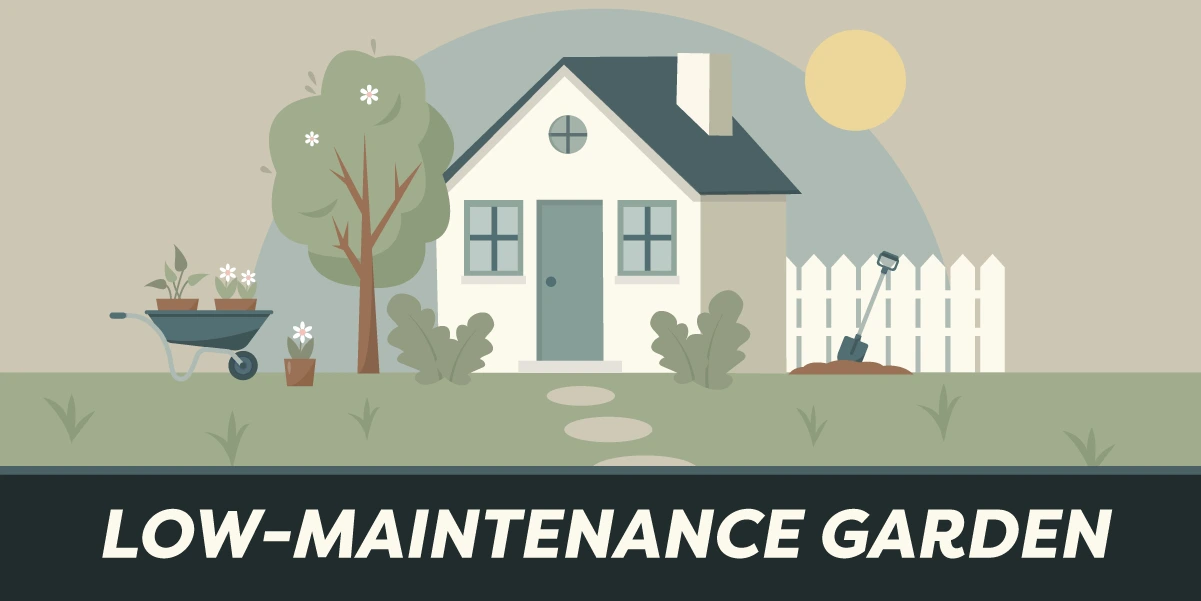We all know a putterer when we see one.
Putterers putter in the yard — digging, planting, pruning, and mowing. It’s a form of therapy.
But when temperatures soar into the 90s, with humidity to match, yard work feels less like therapy than torment. Even putterers avoid it.
Others have no taste for yard work, although they love a lush landscape to view through the picture window.
They just want that landscape to involve less work — much less. The good news is that it can.
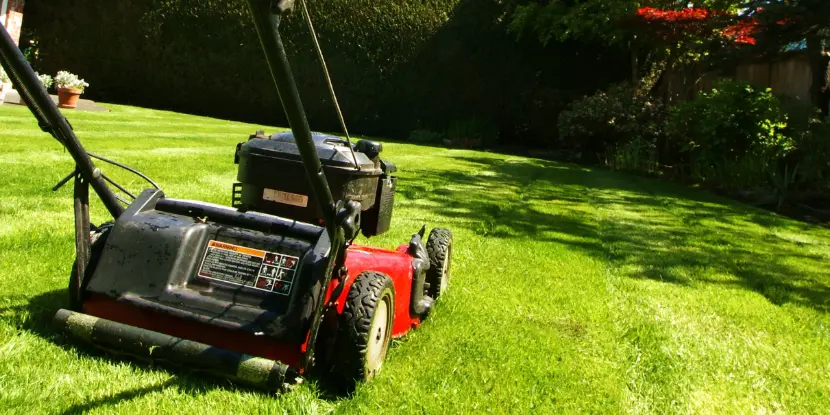
This will be your every weekend with a traditional lawn, unless you hire landscapers, starting at $50 an hour in Southern California.
What’s a Low-Maintenance Landscape?
A low-maintenance landscape features a simpler layout with fewer plants that thrive with minimal care. It reduces the time and effort of upkeep without sacrificing aesthetics.
A well-designed low-maintenance landscape can survive periods of neglect and give you the pleasure of a beautiful yard without demanding constant watering, weeding, and other tedious work.
Here’s how to go about creating one:
1. Choose Native Plants
- Native plants have adapted to the local environment. They require less water and fewer resources.
- They attract local wildlife, such as beneficial insects and birds, enhancing the ecosystem.
- They’re more resistant to local pests and diseases.
- They often have longer blooming periods and provide seasonal interest.

A simple but elegant low-maintenance yard.
2. Group Plants by Water Needs
- Arrange plants with similar watering needs together to simplify irrigation.
- This makes watering routines more efficient and reduces water waste.
- It also promotes healthy growth since plants won’t compete for resources.
3. Install Drip Irrigation
- A drip irrigation system delivers water directly to the plant roots.
- This method conserves water and eliminates manual irrigation.
- It also prevents overwatering and the issues it can cause.
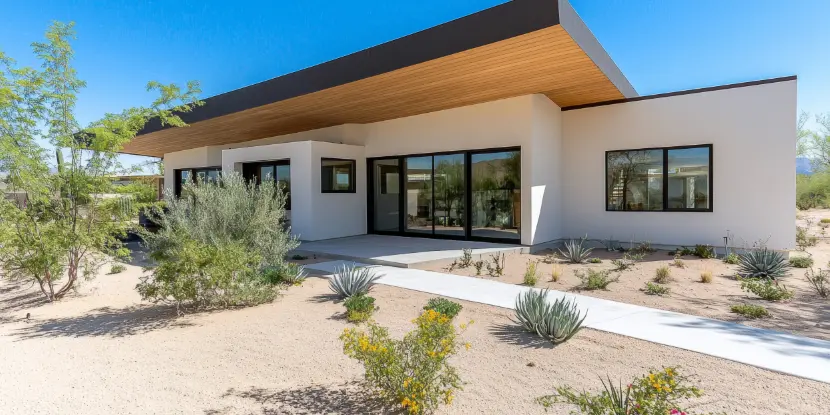
Low-maintenance landscaping doesn’t have to be complicated. Start with gravel mulch and a few drought-tolerant plants.
4. Incorporate Mulch
- Mulching helps retain soil moisture.
- It suppresses weeds, saving you time and effort on weeding.
- Organic mulches provide nutrients as they break down, promoting healthy plant growth.
- Gravel or bark mulches unify the landscape and give it an orderly appearance.
5. Select Perennials Over Annuals
- Perennial plants come back year after year and don’t need replanting.
- They generally require less water and maintenance than annuals.
- It’s possible to build a diverse and ever-changing display with only perennials.
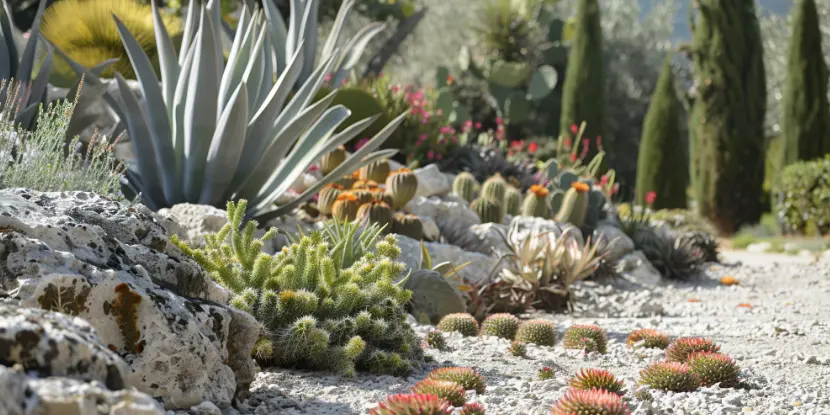
Blending tall plants with dwarf plants and ground cover creates a pleasing contrast.
6. Choose Drought-Resistant Plants
- Succulents, desert grasses, and certain shrubs flourish with minimal irrigation.
- These plants also require little pruning or fertilizing.
- They can add texture and interest to your landscape while keeping maintenance low.
7. Limit Lawn Area
- Lawns require regular mowing, watering, and fertilizing to stay lush.
- Shrink the size of your lawn or use an alternative ground cover like as gravel or native grasses.
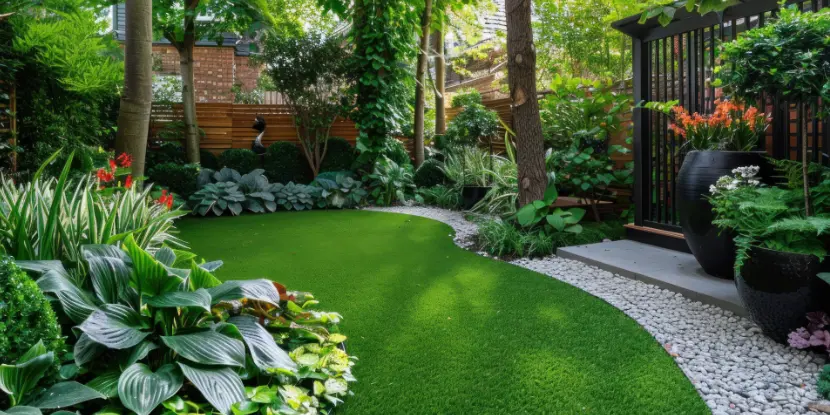
Limit grassy areas that need frequent mowing and upkeep.
8. Use Ground Cover Plants
- Ground cover plants suppress weed growth and reduce the need for mowing.
- They’re aesthetically pleasing with their low-growing, spreading foliage.
- For best results, choose native varieties.
9. Take Advantage of Hardscaping
- Integrate natural stone, gravel, or paving into your landscape to reduce plant density and maintenance.
- Hardscaping elements can define spaces and build visual interest while eliminating the need for grass.
- These durable features require little upkeep compared to plant materials.
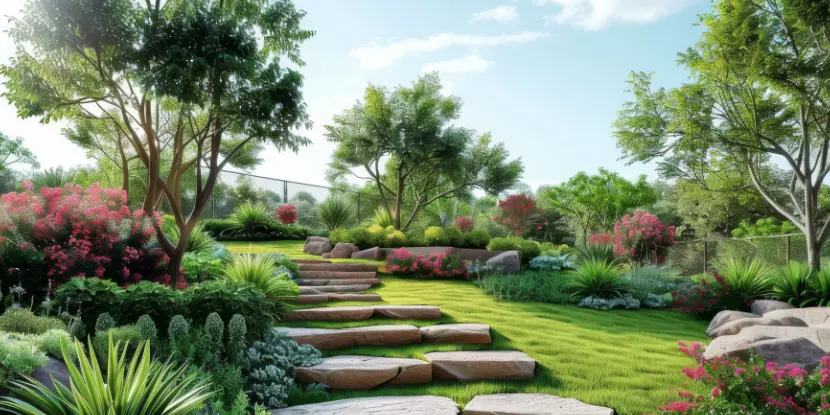
Incorporate hardscape elements like rocks and paving stones to shrink your lawn area. Choose slow-growing grasses.
10. Plan for Easy Access
- Include pathways that give you easy access to all parts of your landscape.
- This will make tasks like weeding, pruning, and fertilizing less daunting.
- A well-designed functional layout can also be inviting.
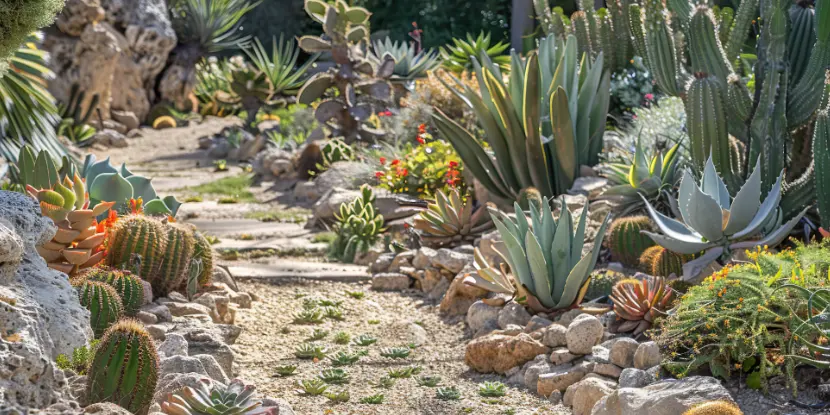
Incorporate pathways and hardscaped resting areas for easy access to garden plants.
11. Consider Turf Alternatives
- Grass must be mowed, watered, and fertilized. It’s the most labor-intensive element of a landscape.
- Consider alternatives like drought-resistant ground covers or gravel mulch.
- If you must have grass, choose a slow-growing variety.
12. Favor Dwarf Varieties
- Choose dwarf versions of plants for a smaller, lower-maintenance version of your landscape.
- These varieties require less pruning and can fit better in small spaces.
- They also reduce the amount of waste produced from trimming and pruning.
13. Choose a Variety of Texture, Height & Color
- A mix of plants with different foliage textures and colors can create an eye-catching, low-maintenance landscape.
- Combine spiky plants like ornamental grasses with rounder, fuller shrubs for contrast.
- Varying colors and heights can add depth and interest to your landscape.
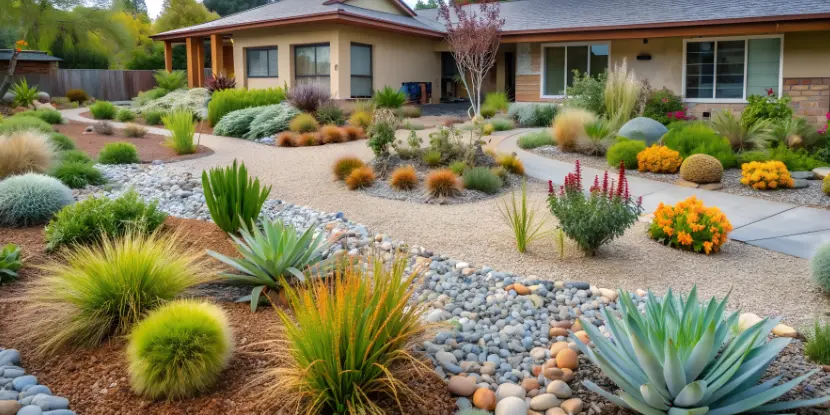
A beautifully xeriscaped yard with highlights of flowering plants.
Xeriscaping, the Ultimate Low-Maintenance Landscape
Xeriscaping is a landscaping philosophy focused on drought-resistant plants and efficient landscape designs.
The term “xeriscape” was coined in the 1980s by the Denver Water Department as a combination of the Greek word “xeros,” meaning dry, and “scape,” which refers to the landscape.
The concept emerged as a response to water shortages and the increasing need for sustainable gardening practices.
By adopting xeriscaping principles, homeowners can slash their water bills, support environmental conservation, and still enjoy the benefits of a picturesque yard.
Features of a Xeriscape
- Incorporates native and adapted plants that thrive in dry conditions.
- Uses drip irrigation and rainwater collection systems.
- Focuses on soil health and structure.
- Applies layers of mulch to conserve soil moisture and suppress weed growth.
- Reduces or eliminates traditional grass lawns in favor of low-growing ground covers and hardscaping.

A spectacular xeriscaped yard with flowering ground cover plants, drought-tolerant trees, and gravel pathways.
Benefits of Xeriscaping
- Significantly reduces the amount of water needed for landscape maintenance.
- Minimizes the need for mowing, fertilizing, and pest control.
- Decreases water bills and maintenance costs.
- Supports local wildlife and promotes biodiversity.
- Creates stunning landscapes that highlight the beauty of native plants and sustainable design.
Additional Tips for Maintaining Your Low-Maintenance Landscape
- Use organic fertilizers instead of chemical fertilizers that require regular application. Organic options include compost, straw mulch, and natural plant-based fertilizers.
- If you do have a lawn, keep it small and use native grasses that require less water and maintenance.
- Choose disease-resistant plants. This will save you the time and effort of treating or replacing sick plants.
- Keep up with mulching to retain moisture and prevent weed growth.
- Only prune as needed, and choose low-maintenance shrubs.
FAQs: Low-Maintenance Landscaping
Q: Can I still have a beautiful yard with minimal upkeep?
You can have a spectacular, low-maintenance landscape with proper planning and plant selection.
Q: What are some challenges of maintaining a traditional high-maintenance landscape?
High water consumption, frequent mowing and weeding, and constant pruning and fertilizing are common problems and inconveniences.
Q: What’s the benefit of using native plants in a low-maintenance landscape?
Native plants require less water, attract local wildlife, and are more resistant to pests and diseases.
Q: Will I still need maintenance in a low-maintenance landscape?
There will still be some upkeep, such as occasional watering, mulching, and pruning. However, it will involve significantly less work than a traditional landscape.
Q: Can I still have a lawn in a low-maintenance landscape?
You can opt for drought-resistant grasses or alternatives like ground covers or hardscaping elements.
Q: How much time will I save by implementing these tips?
That will vary depending on the size and complexity of your landscape. Generally, a low-maintenance landscape can save you hours each week compared to a traditional, high-maintenance landscape.
Q: What if I still enjoy yard work and want to do more than just minimal upkeep?
You can still incorporate a few high-maintenance plants or features into your landscape as long as they don’t require constant attention. Remember to balance them out with low-maintenance options.
Additional Resources
- The Xerces Society: A nonprofit organization promoting pollinator conservation through education and research.
- Audubon Native Plants: An online database that helps homeowners choose bird-friendly native plants based on location.
- American Horticultural Society: A resource for gardening tips and inspiration, including kid-friendly gardening activities.
- WaterSense: An EPA program that provides resources and information for water-efficient landscaping and outdoor practices.

